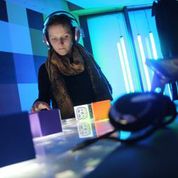How can technology help to give children good lives?
In cooperation with the LEGO Foundation and Intel, Aarhus University is hosting the world’s biggest international research conference on children and technology. The event will take place in Aarhus on 17-20 June.

For four days, leading researchers from all over the world will be meeting representatives of the business community to discuss the latest knowledge about technology and its importance for children’s development, wellbeing and learning. The conference is called Interaction Design and Children (IDC). It’s an annual conference that brings together research and industry at the intersection between technology, children and learning. Last year the conference was held in New York City, in 2015 it will be held in Boston, and this year it’s in Aarhus.
“All kinds of research laboratories will be opening their doors at the conference, with new technologies, research methods and techniques related to design for (and with) children being discussed by international experts. One of the central questions at the conference is how new technologies can help children to have good lives,” explains Professor Ole Sejer Iversen from the Center for Participatory IT at Aarhus University. He is responsible for the conference.
Support from the business community
This year’s IDC conference will be concluded at the LEGO Foundation in Billund, with all the participants working alongside designers and researchers from the LEGO Group to generate new ideas for the development of technologies to support children’s creativity and development.
“The IDC network contains the most progressive researchers in the world within the field of interaction design. For many years this network has been studying the question of how new digital products and experiences can make a positive difference in the everyday lives of children. We support this agenda, and the LEGO Foundation is particularly interested in launching a discussion of the best way of helping children to retain their curiosity and continue to learn throughout their lives. One way of helping them is by creating and designing new creative digital tools,” says Bo Stjerne Thomsen, Director of the LEGO Foundation. And he adds: “It’s in research environments like this one that the importance of play for learning and children’s development needs to be put on the agenda, and we’re delighted to have the chance to co-host this year’s conference.”
Facts about the Interaction Design and Children conference
- The conference will be held on 17-20 June.
Read more about the conference at www.idc2014.org
- The day before the conference, on 16 June, Aarhus University is hosting a conference called “FabLearn Europe” in collaboration with the University of Bremen and Stanford University. International researchers will be meeting school managers from the municipalities of Aarhus, Vejle and Silkeborg to discuss the most important challenges with regard to future teaching and collaboration in FabLab@school.
Read more about the conference on 16 June at www.fablearn.eu
For further information
Professor Ole Sejer Iversen
Mail: oiversen@cavi.au.dk
Tel.: (+45) 8716 1996
Mobile: (+45) 5054 6778
